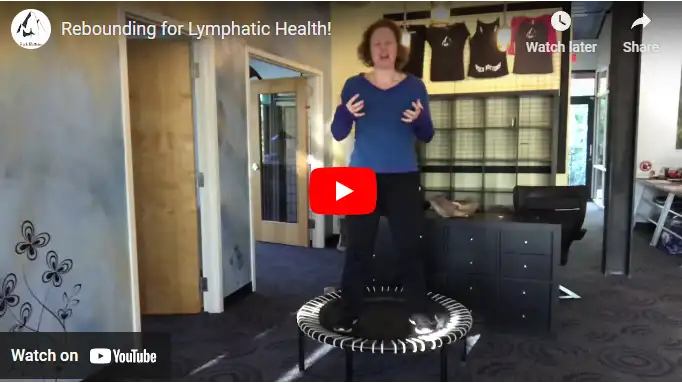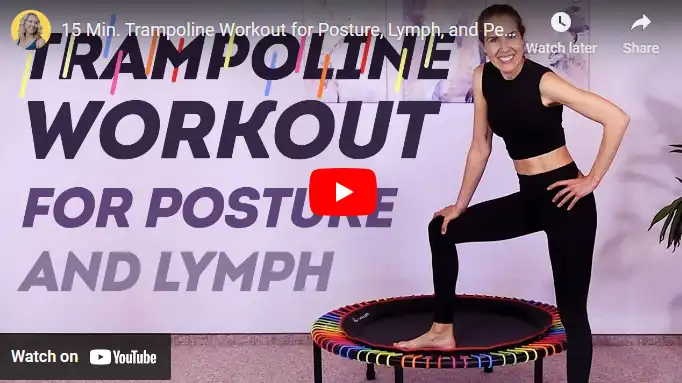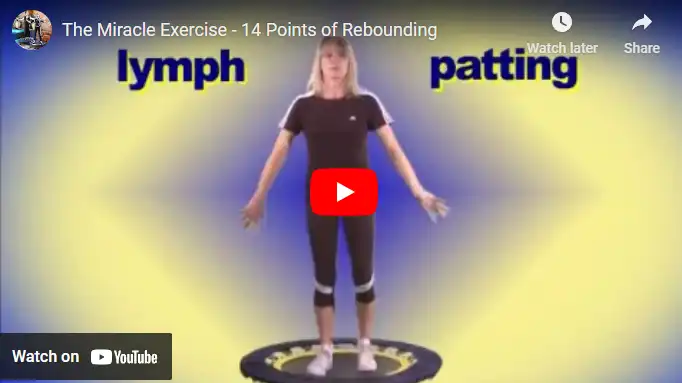Rebounding For Lymphatic Drainage: Why And How To Do It
Disclaimer: This website exists thanks to you, the readers. When you buy through links on my site, I may earn an affiliate commission.
Let's get real for a moment – we all know staying active is staying healthy, right?
Well, let me introduce you to a game-changer: rebounding for lymphatic drainage. Remember when I told you about the amazing perks of bouncing on a mini trampoline for weight loss? It's not just that; rebounding is a powerhouse activity that supercharges your health, sends your mood soaring, and even gives you that glowing, confident vibe.
But today, I’m going to zero in on a standout benefit: lymphatic drainage. Trust me, this is one topic you're going to want to jump right into!
What is lymphatic drainage?
The lymphatic system, which is a main part of the immune system “protects you from infection and destroys old or abnormal cells your body doesn’t need.” It is a critical part of the body's immune system and consists of a network of vessels, nodes, and organs.
Like the circulatory system that moves the blood, the lymphatic system has its own fluid — the lymph. A big difference is that the circulatory system has the heart to pump blood, while the lymphatic system doesn’t have a pumping organ. Lymph moves naturally only when your muscles contract.
When you move, the lymph fluid moves. This is lymphatic drainage.
Why rebound for lymphatic drainage?
Now I said “when you move, your lymph moves”, and that implies all types of movement or exercise. So, why choose rebounding then?
Dave Scrivens, a Certified Lymphologist, says that using a mini trampoline for lymphatic drainage is better for lymphatic drainage than other exercises because the body makes vertical motions.
He explains:
“The lymph fluid moves through channels called “vessels” that are filled with one-way valves, so it always moves in the same direction. The main lymph vessels run up the legs, up the arms and up the torso. This is why the vertical up-and-down movement of rebounding is so effective to pump the lymph.”
Many others report the positive result of rebounding on the lymphatic system.
For example, according to the nutritionist Ann Louise Gittleman, author of “The Fat Flush Fitness Plan”,
“Using a mini-trampoline will help you exercise your lymphatic system, which rids your body of bacteria, toxic wastes, fat globules, trapped protein and dead cells.”
My personal experience also suggests that rebounding is helpful for lymphatic drainage. It’s what helped me get rid of cellulite. And I recently read a study that suggests lymphatic drainage does help in fighting cellulite.
The link between jumping on a mini trampoline and lymphatic drainage is not yet fully known, but it is there.
The benefits of rebounding for lymphatic drainage
Here is more about the benefits of rebounding for lymphatic drainage.
Increased lymphocyte activity
Studies suggest there is a direct relationship between the work of lymphocytes and working out. While rebounding, you help the lymph move, and that way your body produces more lymphocytes (as much as 15 times more!). This means a stronger, healthier body.
Detoxifying effect
The lymphatic system cleanses your body from dead and cancerous cells, nitrogenous wastes, infectious viruses, heavy metals, and others. Jumping on a rebounder helps it drain away all these poisons.
Rebounding is a great choice for an intensive workout. Especially if you don’t want the pressure jogging puts on your ankles and knees.
Boosting immunity
No, it's not one of those myths about rebounding! The lymphatic system is a key element of the immune system. Apart from helping the body cleanse from toxins, it also naturally helps in boosting the immunity of the body. That’s because, when rebounding, you boost the work of the lymphatic system and the production of white blood cells. They are also a part of the immune system and play a critical role in protecting the body from different illnesses and diseases.
My top 3 rebounders for lymphatic drainage
You can use any rebounder for lymphatic drainage, as long as you are comfortable bouncing on it. The ones I’m suggesting here are my personal favorites for this type of exercise. Keep in mind that a rebounder is different than a full-sized trampoline.
Generally speaking, bungee trampolines have a softer bounce than spring trampolines. At the same time, there is one big exception — the Cellerciser®. It does have springs, but because of the special design, the bounce is gentle, yet it doesn’t let the mat sag in the middle. Sagging is a problem for some bungee rebounders, on the other hand. You can read my Cellerciser® review here.
I’d recommend getting a rebounder with a bar for better support, especially if you’ve never had a rebounder before.
Product | My Rating | Verdict | Price |
|---|---|---|---|
There's nothing like the bellicon for lymphatic drainage. Its premium bungees create a deep, gentle bounce that stimulates the lymphatic system very effectively. Plus, it feels like jumping on a cloud! | |||
The unique spring technology of the Cellerciser offers a gentle but also firm bounce that is great for lymphatic exercises. This mini trampoline is great value for money, considering how well-built it is. | |||
The BCAN is silent and steady, and it has a high capacity. It’s great value for its cost and has ample jumping space. The handlebar offers good stability to beginners. |
How long to rebound for lymphatic drainage
The time it takes to see benefits from rebounding for lymphatic drainage can vary, but general recommendations suggest that 10 to 20 minutes of rebounding daily is effective for stimulating the lymphatic system.
If you're just starting, you might want to begin with 5 to 10 minutes and gradually increase the time as your body adjusts. If you have any underlying health conditions, especially lymphedema, be very careful. Experts suggest people with this condition start with 2-3 minutes of gentle bouncing with feet on the mat.
Lauren Roxburgh from Aligned Life Studio says:
“The simplicity of the rebounder is one of my favorite things about this workout -- you only need 15-20 minutes of bouncing to get your heart pumping, tone your body, flush out toxins and detoxify your system.”
The more you exercise, the more your lymphatic system will work. My experience shows that a 40-minute workout with various types of exercises incorporated is enough for you to feel better and to get results for your health later.
How often should you rebound for lymphatic drainage?
“Rebounding 3-5 times per week at a minimum of 10-15 minutes at a time is highly beneficial.* It is effective at a minimal bounce, using acceleration and deceleration, with each bounce, to open and close the one-way valves between the lymphatic system and the cells.”
In my experience, 3-5 times a week is the Goldilocks amount, too. More than that, and you put your body under constant tension. Less than that, and you don’t feel the benefits.
What I discovered for myself is that rebounding is easy and fun and makes you look forward to the next session. You simply need to put some of your favorite music on and remind yourself of the times you were a child. Jumping freely is always a good idea!
Here is a nice rebounding workout to help you get excited about the next section:
Best rebounder exercises for lymphatic drainage
I’ve already answered some of the burning questions, like what’s the link between rebounding and our lymphatic system, how long to rebound for lymphatic drainage, and how often. Now let’s talk about how to use a rebounder for lymphatic drainage!
I’ve already shared a variety of exercises for weight loss. But lymphatic drainage is a bit different, especially if you have a condition like lymphedema. Here is a short list of movements you can start doing if lymphatic drainage is your goal.
The Health Bounce
Coined by Dave Hall, the health bounce is the gentlest, easiest exercise you can do on a rebounder. This is enough to get your blood pumping, along with all the great health benefits that stem from that. This exercise can serve as a warm-up in your practice.
How to do it
You simply have to grab the handlebar of your mini trampoline and lift your heels up and down. That’s it! You don’t even have to jump. If that’s too challenging, you can try keeping your feet flat and just bending the knees up and down.
The Light Bounce
Light bouncing for 10 to 15 minutes in the beginning is enough to boost the lymph system, advises Ellen Kamhi in her book "Alternative Medicine Magazine's Definitive Guide to Weight Loss." When you land on the rebounder after jumping, you feel twice the force of gravity. That’s what causes the lymph channels to expand and gets your lymph moving.
How to do it
Feeling the gravity at such a level might sound harmful, but that’s another benefit of rebounding. The elastic surface of the trampoline actually absorbs much of that and protects your ankles, knees, and back.
The Strength Bounce
Let’s get the tempo up! With this exercise, you also start to include your hands. By engaging more parts of your body, you burn more toxins and strengthen more muscle groups. This type of exercise helps improve balance because it engages both the legs and the hands.
How to do it
You simply have to bend your knees and push up for a jump. While jumping, swing your hands up.
The Kick Bounce
This is another exercise that involves both the legs and the hands. It can be a bit difficult for some people, especially beginners, so be careful. And get ready to get sweaty! 😅
Remember to do each exercise only for as long as you can. Push yourself, but don’t overdo it. My advice is to always try to do multiple exercises during your routine.
How to do it
The moment you start going up, kick one leg out to the front. When landing, put it back down. When your right leg is out, swing your left arm out with it, and then switch.
The Marching Bounce
I think the title is pretty self-explanatory. You march and you bounce (sort of). You can use this one as a cool-down.
How to do it
The trick is to bring your knees as high as possible. This will help you get better results.
Don’t forget to keep your balance on the rebounder, though. Swing your hands back and forth when you march. When your left knee is up, put your right hand to the front and vice versa.
The best rebounders for lymphatic drainage
Any rebounder can be helpful for lymphatic drainage. Rebounding in general is considered beneficial for lymphatic drainage because of the vertical motion you do when jumping. This causes the otherwise closed lymph valves to open up, moving your lymph fluid.
To choose the right rebounder, you need to consider your personal metrics (weight, height, age, etc.). Then, you should check its bounce quality as well as the quality of the materials it's made of. The safety features are also a key thing to look for. Keeping these specifics in mind, I did a lot of tests to find the best mini trampolines for lymphatic drainage. I’ll try to give you the best 3 options on the market.
If you have a big enough budget, I'd recommend the one and only bellicon. It's like the luxury car of rebounders—smooth, stylish, and built to perform. The premium bungee cords give you a soft bounce, which is great for getting your lymph fluid moving without jarring your joints. It’s gentle, fun, and oddly satisfying, like bouncing on a cloud. Plus, it’s easy on your body but tough enough to handle daily use. Perfect for anyone looking to detox and feel amazing while doing it!
If you want value for money and you don't care about customisation, I’d recommend getting the Cellerciser®. Because of the special tri-daptable (or three-section) springs, it’s much easier to jump on. It doesn’t sag in the middle like some bungee trampolines might. At the same time, the bounce is much softer, compared to other spring trampolines. You could say it’s the best of both worlds. I think this gentle bounce that doesn’t let you sink is what makes it good for lymphatic drainage because you can move without too much effort.
My budget choice would be BCAN 40/48/50 Inch Foldable Mini Trampoline. It’s a stable mini trampoline with a good quality mat and excellent weight capacity. That also makes it very durable for heavier weight or more intensive jumps. The BCAN comes with a handlebar and its jumping area is large, which makes it perfect even for beginners. Lastly, it’s quiet, which might be a priority for some people.
FAQ
How do you speed up lymphatic drainage?
As Dr. Scrivens explains in his article:
“Lymphatic flow requires muscular contraction from exercise and movement, gravitational pressure, and internal massage to the valves of lymph ducts. Rebounding supplies all three methods of removing waste products from the cells and from the body."
But it’s not limited to rebounding. The more you practice sports, the more you stimulate lymphatic drainage. Even a simple walk will have an effect!
How long does it take for lymphatic drainage to work?
There isn’t an exact answer to this question because it always depends on your personal specifics (age, weight, health condition). Overall, it might only take 10 to 15 minutes to activate lymphatic fluid to flow. Be mindful of your own physical features, do a little warm-up, and you can be sure that even 15 minutes of rebounding a few times a week will help you get your lymph moving.
Is rebounding good for over 50?
Rebounding in itself has no age limit and it’s proven to be very beneficial for the elderly, improving balance, posture, and even bone density, among other things. That’s due to the elastic material of the mat and the flexibility of the cords or springs because it’s easy on the joints and ankles when you land on the rebounder. Still, it’s important to first consult a doctor before buying a mini trampoline to make sure it’s safe for you personally.
Conclusion
Jumping into the world of rebounding for lymphatic drainage not only boosts your health but also taps into the natural detoxifying processes of your body. The connection between rebounding and the lymphatic system is yet to be explored in-depth, but it is already showing a lot of results.
When you do these simple but effective exercises, you improve lymph movement, which helps to remove toxins and increases immune function. Rebounding proves itself as more than just a workout; it's a fun and powerful way to support your overall well-being. So why not give it a try? Embrace the bounce and let your body experience the myriad benefits of lymphatic drainage!
References and further reading
- “Rebounding: Good for the Lymph System”; Dave Scrivens, Certified Lymphologist, Well Being Journal, Vol. 17, No. 3.
- “The Fat Flush Fitness Plan”; Ann Louise Gittleman (Author), Joanie Greggains (Author); 2003
- “Acute exercise and immune function. Relationship between lymphocyte activity and changes in subset counts”; S. Shinkai, S. Shore, P. N. Shek, R. J. Shephard; 1992
- “Rebounding and Your Immune System”; Linda Brooks; 2003
- “Body acceleration distribution and O2 uptake in humans during running and jumping”; A Bhattacharya, E P McCutcheon, E Shvartz, J E Greenleaf; 1980
- “Alternative Medicine Magazine’s Definitive Guide to Weight Loss”; Ellen Kamhi; 2007
- “The Benefits of Sweating & Detoxing Your Body”; Amy Myers, MD
- “A study to assess the effectiveness of rebounding exercise on lymphedema”; Shailendra Mehta
- “Considering the hypothesis of the pathophysiology of cellulite in its treatment”, de Godoy JMP, de Godoy ACP, Godoy MFG, Dermatol Reports, 2017
- “Lymphatic System”, Cleveland Clinic, 2023






